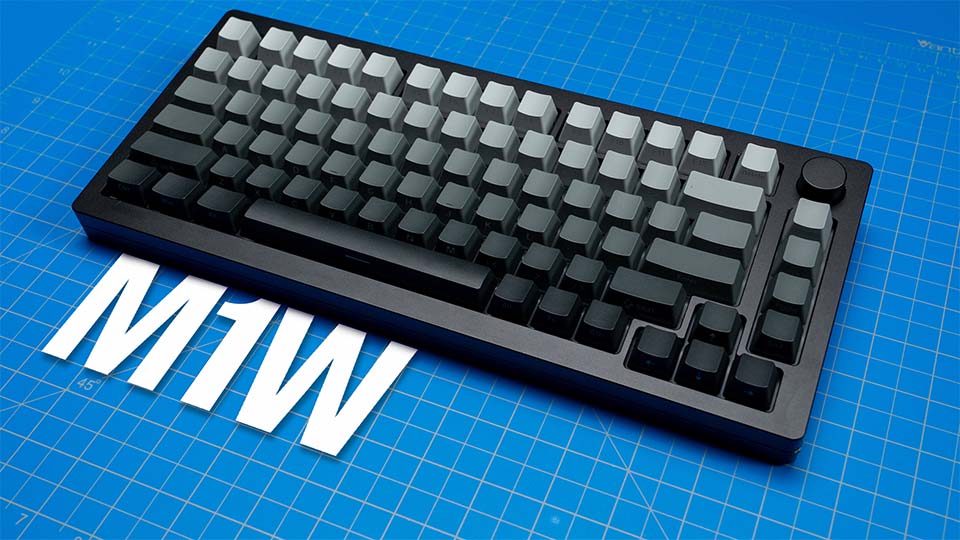Links in this post may be affiliate links. Any products purchased through affiliate links may provide a small commission which helps to support the SemiPro Tech+Gear site and YouTube channel.
The Monsgeek M1 came out as an all-metal 75% wired keyboard at the accessible price of $99 for a kit without switches and keycaps. Now, the M1W adds wireless connectivity and only a modest price increase, to $109 USD. Is the wireless model an overall improvement, or is it a step backwards for Monsgeek?
Well, it’s a bit of a mixed bag in my opinion. While the build quality is excellent and far beyond what I would expect for anything under $150 and the included switches in the assembled version are also quite nice, there are a couple of downsides that unfortunately mean it won’t be the best option for everyone.
Monsgeek M1W
MSRP: $109 (barebones kit) / $139 (fully assembled)
Pros
- Build quality well beyond the price point
- V3 Piano Pro switches are smooth and stable
- Modification supplies included! (tape mod, force break, foam)
- Software allows you to customize (though not as much control as QMK/VIA)
Cons
- OS/connection switch is beneath the caps lock keycap
- 2.4GHz connection seems finicky
- Assembled model comes with side-legend keycaps
- No QMK/VIA
Best For: Those who don’t switch between Mac & Windows OS frequently.
The Good
As I mentioned above, the build quality is very good for a keyboard in this price range. Pre-built keyboards in the $130-150 range commonly still feature some ABS plastic in the construction – for example the $129 Nuphy Halo75, an excellent 75% keyboard, has an ABS plastic bottom and aluminum top frame. The M1W is solid aluminum top to bottom, and it’s no cheap machining either – edges are smooth and I found no imperfections on my example. The case build is reminiscent of much more expensive keyboards like the $199 (assembled) Keychron Q1 Pro or the $169 (barebones kit) Glorious GMMK Pro.
The switches in the assembled version, AKKO V3 Piano Pro linears, are also quite nice. They are smooth and stable thanks to factory lubing and a box-style stem. The 45g springs are the typical weight of a classic red switch, but they feel just a tad light to me.
Monsgeek also provides some nice modification options in the box, even with the fully assembled version. They provide some small pads to add a force break mod around case contact points, a pre-sized sheet of tape for a tape mod, and extra case foam if you prefer the sound with added foam. This is something common with custom keyboard build kits from suppliers like KBDfans (which can easily cost $200-300 or more), not budget-friendly mechanical keyboards that come pre-assembled. And I mean this as a good thing – it’s nice Monsgeek is encouraging us to tinker.
The Not So Good
In spite of those positives, unfortunately, there are a couple things that make the M1W not the best option for everyone in my opinion. My biggest issue with the M1W was the decision to put the OS/connection switch underneath the caps lock keycap. You have to remove the caps lock keycap to reach a tiny switch that is hard to reach even with the keycap removed, just to change between the Windows and Mac modes as well as between the standard wired connection and the wireless options. The standard wired mode is by default set for Windows. You can still put the M1W into wired mode in the other switch positions with a key command. However there is no key command to switch between Mac and Windows layouts without moving the switch position.
I’m confused by this. It seems as if Monsgeek believes the majority of customers are going to be Windows users with no need to utilize the switch on a regular basis. If that is your situation, then this won’t be an issue for you. However I personally switch between a Windows laptop and Macbook multiple times each day at my desk, so this would drive me completely bonkers.
I made several attempts to find a way to swap layers with a key command using the Monsgeek Cloud Driver software (it’s not QMK/VIA compatible) with no success. I was able to assign the modifier keys for Mac & Windows to different layers, but without the ability to enter my own custom QMK command to toggle the layer on/off (TG(layer#)), I could not assign any keys to swap between layers. A very simple solution that many other manufacturers employ would be to place the physical switch somewhere on the outside of the case (NuPhy, Keychron), or to program a key command to change layouts (such as Fn + M for Mac). QMK/VIA compatibility would also solve this.
A second issue I ran into was a shaky 2.4GHz connection. I plugged the receiver into my Macbook Pro directly, not into a dock, at a distance of 53 inches with a clear line of sight to the keyboard. I use this setup frequently to test keyboards and have not run into interference or spotty signals with other wireless boards. But with the M1W I never had a solid connection over 2.4GHz. It would be normal at first every time I plugged it in, and then after about 30 seconds it would start missing key presses and having serious latency for the keys that registered. To rule out other hardware issues, I tried this on multiple ports and also changed out the USB-A to USB-C adapter that is necessary since the Macbook Pro (M1 Pro) only has thunderbolt ports. Just for fun I also plugged the receiver into the USB-A port on my Caldigit TS4 dock and still had the same issue. It’s possible my unit has a defect, but it was disappointing nonetheless.
One other small thing I would point out is subjective and specific to the assembled version – the provided keycaps are the side-legend variety. I understand why they did this (unlike the OS switch) – the LED lightning of the PCB is south-facing, so the more typical shine-through top legends would not be illuminated very well. The legends on these keycaps do illuminate well, but let’s face it: side legends are not for everyone. I don’t have a strong dislike for them, but they’re not the “standard” legend style for a reason.
Sometimes when reviewing a keyboard, I have a hard time answering the question “who is this for?” because the issues I’ve found may be mostly subjective matters of preference or just non-issues for some people. With the M1W, I find it pretty straightforward to answer this question.
If you’re a user who needs to switch back and forth between Mac and Windows computers frequently, I do not recommend the M1W. In addition, if you rely on a 2.4GHz connection as your primary method, this was another weakness for the M1W (though I recognize my example may be a fluke).
However if you’re a user who can set the switch to your OS and never move it, and if you plan to use bluetooth more frequently than 2.4GHz, then I would say the M1W might still be a good option to consider. The build quality and general typing experience is very good for this price range, so if my two biggest concerns don’t apply to you, I see no reason not to at least consider it.
Check out the M1W
Keyboard Specs:
Price: $109 USD (barebones kit) / $139 USD (assembled ) / $149 USD (assembled-ISO)
Layout: ANSI 75% | 82 keys (ISO layout also available)
Switch Options: AKKO V3 Piano Pro (assembled version)
Hot-swappable: Yes
Connectivity: Bluetooth for 3 devices, 2.4GHz, USB-C wired
OS Compatibility: mac/windows
Typing angle: not stated (non-adjustable)
Frame: CNC aluminum
Bottom case: CNC aluminum
Keycap: PBT, double-shot, shine-through (OEM profile)
Dimensions: 333 x 146 x 32.6mm
Weight: 4.85 pounds (2200g)
Battery Capacity: 6000mAh


